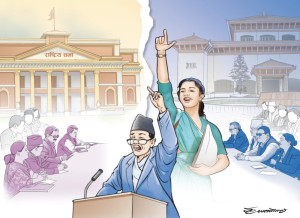Columns
Nepal is open for business. But where is the investment?
Being one of South Asia’s smallest recipient of foreign direct investment, Nepal needs to improve..jpg&w=900&height=601)
Bishal Bhattarai
With growing fatigue towards foreign aid, the development paradigm has been shifting towards foreign direct investment. Foreign direct investment seeks to maximise the use of available resources, marketise the outputs within and outside a country and enhance efficiency by transferring skills and technologies into a country, along with the necessary capital. Like foreign aid, it tries to fill the gap between import and export, domestic investment and saving, and the availability of foreign exchange.
In recent times, the overall flow of foreign direct investment has been on the decline. For example, in 2018, it declined by 13 percent to total $1.3 trillion globally. The growing tensions in the Middle East and West Asia, the rise of protectionism and popularism, Brexit and the Trumpian policy of America First, among others, have contributed to this global shrinkage.
However, when considering FDI region-wise, South Asia, Southeast Asia, West Asia and Africa benefitted slightly whereas Latin American and Caribbean countries and developed economies like Europe, America and the UK were the losers.
Although the FDI attained by least developed countries rose slightly, it still only amounts to 1.8 percent of the total FDI. Similarly, the foreign direct investment in the landlocked developing countries is just 1.7 percent of the total investment. The US ($252 billion) still tops the list in terms of attracting more FDI followed by China ($139 billion), Hong Kong ($116 billion) and Singapore ($78 billion). India is in the 10th position with $42 billion. In terms of outflow of FDI, Japan ($143 billion) is at the top followed by China ($130 billion), France ($ 102 billion), Hong Kong ($85 billion) and Germany ($77 billion).
Investment in Nepal
As per the available data, the total amount of FDI in Nepal was $161 million in 2018, which was just 0.01 percent of the overall flow of FDI. In fact, Nepal received a lower share of the total than India, Bangladesh ($3.6 billion), Pakistan ($2.4 billion), Sri Lanka ($1.6 billion), the Maldives ($552 million). Although Nepal has organised two investment summits within the last three years, the flow of FDI is minimal. That it received lesser investment than the Maldives is particularly telling. The country needs an annual investment of at least Rs1,200 billion to meet the Sustainable Development Goals. Therefore, the current amount is severely insufficient.
The major sectors that receive foreign investment include services, industries and agriculture. FDI in the services sector is divided among transport, storage and communication, financial intermediation, education, hotels and restaurants. In contrast, foreign investment in industrial sectors is mainly focused on hydropower, cement, paints, beverages and steels. FDI in agriculture is mainly channelled into coffee plantations and herb processing firms. More than three dozen countries are investing in Nepal, and prominent among them are India and China.
After the restoration of democracy in 1990, Nepal has enacted several acts, regulations, directives and working manuals to ease the process of bringing foreign investment into the country. It has also become a member of various international organisations including WTO, SAFTA and BIMSTEC. Similarly, it has also signed many bilateral, sub-regional, regional and global treaties, agreements and conventions to augment FDI.
What ails FDI
Despite the continued emphasis on promoting FDI, it is below one percent of Nepal’s GDP. Unless the climate pertaining to conducting business is improved by a vast margin, domestic investors themselves will be unwilling to invest in Nepal, nevermind foreign investors. Policy stability and installing confidence among investors is the bare minimum prerequisite for enhanced investment.
Continued low capital expenditure is a matter of great concern as it impedes the required infrastructure development as well as the liquidity flow in the market. The labour disputes, alleged cases of extortion from the contractors and bureaucratic and political hassles are adversely affecting the investment climate. Every investor weighs in the risks of return; duping with false information does not work for too long, since there are more transparent and ready markets in the world.
Nepal has already realised the need for foreign direct investment. It has already identified the probable areas where such investment is necessary, and the country has enacted several laws and acts to support outside investment. Now, to move forward, it should focus on proper implementation. Political and labour disputes should not lead to the closure of industries. Better coordination between the three layers of government and the private sector is a must.
Nepal is a decent-sized market, with a population of 30 million. Moreover, there are larger markets available immediately across Nepal’s international border on both sides. This would automatically make the country a ripe are for investment. What is needed is clarity in policies and sincerity in their implementation.
***
What do you think?
Dear reader, we’d like to hear from you. We regularly publish letters to the editor on contemporary issues or direct responses to something the Post has recently published. Please send your letters to [email protected] with "Letter to the Editor" in the subject line. Please include your name, location, and a contact address so one of our editors can reach out to you.




 5.39°C Kathmandu
5.39°C Kathmandu













%20(1).jpg&w=300&height=200)

